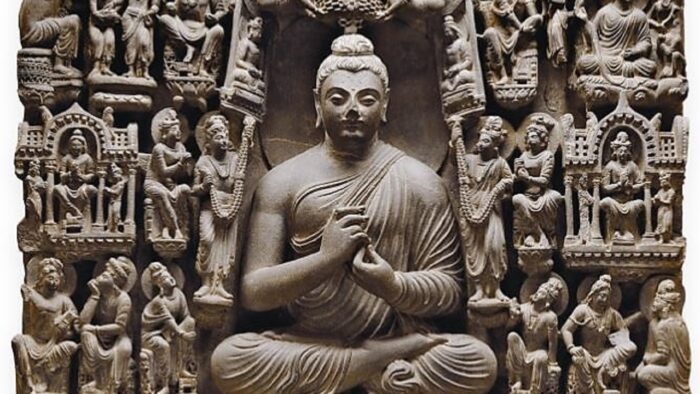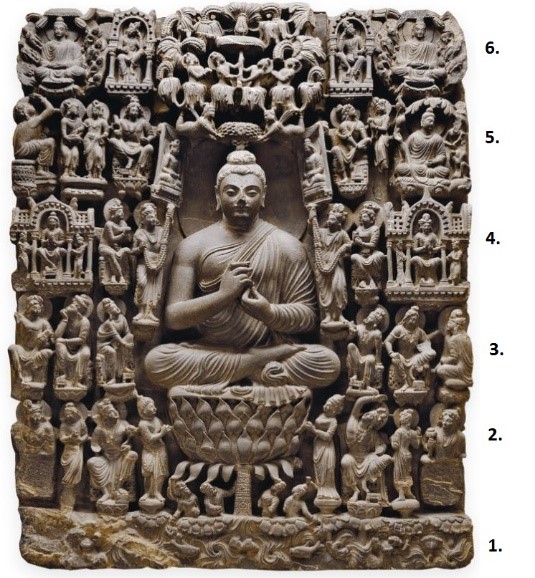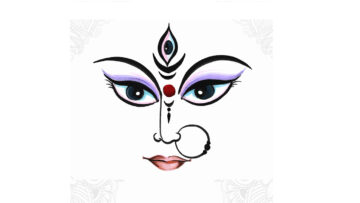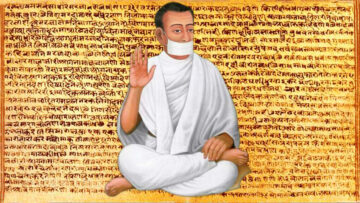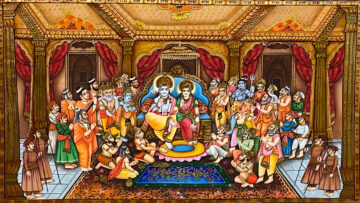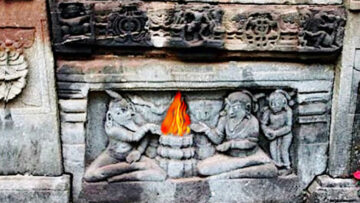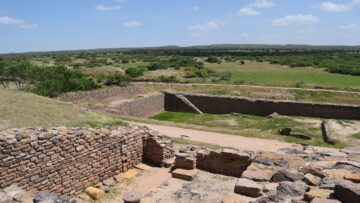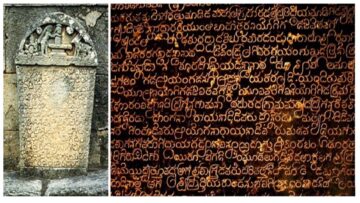A panel with depiction of miracles performed by Buddha in Shravasti, is now in the Lahore museum. Gandhara style of art mostly had big sculptures like Bamyan Buddha of Afghanistan. This panel has over 60 small figures which is a rare representation of Gandhara style. Since the panel is based on miracles of Buddha performed in a place called Shravasti, and executed in Gandhara style of are, three aspects are to be understood like
- why Shravasti was chosen by Buddha to perform miracles.
- why Buddha performed miracles, and
- significance of Gandhara style of art.
Shravasti corresponds to the present day Gonda district of Uttar Pradesh. According to historic data, Shravasti, was one of the six largest cities, was situated on Gangetic plains and Buddha spent most of his life in the monastery of Shravasti. Shravasti and Rajagriha were the capitals of Kosala and Magadha, and also great commercial centers in ancient India.
The phrase ‘miracles performed by Buddha’ sounds strange as Buddha was the one who realized the cause of suffering with a scientific approach and preached the four-fold truths of misery and laws of dharma (righteous conduct) through the eight-fold path. Lord Buddha, 7 years after his enlightenment, performed miracles of supra mundane powers for 15 consecutive days to confound his critics, convince the non-believers in Buddha’s teachings, and to prove a point and install faith in a place called Shravasti. These miracles are documented in some of the stupas in Gandhara style of art. Though this panel does not record all the miracles in order, some of them are depicted on which this article is founded.
King Bimbisara, the ruler of Rajagriha was an ardent follower of Buddha and his teachings. His brother, Prasenjit, king of Kosala, though a follower of Buddha’s teachings, was influenced previously by the six heretical unorthodox teachers, who stayed at the same time of Buddha and followed their different path for liberation. The six heretical teachers displayed some of their powers as miracles and challenged if Buddha could excel them in miraculous power. They demanded king Prasenjit to fix a place and time for inviting Buddha for this event. Buddha accepts the challenge but postpones it by six times as he had declared it will happen only at the right time. On the request of the King Prasenjit to Buddha, to subdue the pride of the six teachers, and on the urge of the merchant Sudatta, who was a follower of Buddha, a place gets fixed in a wide field of Shravasti and the lion throne was placed for Buddha. Buddha performed miracles for 15 consecutive days, each day offerings were made by different kings and groups of followers. These miracles, performed by Shakyamuni Buddha got depicted in many Buddhist monuments, viharas and monastries, from the 1st century A.D, and became a popular art depiction even in the rock cut caves of 5th-6th centuries of western India. Though all miracles were not recorded in sequence, part of it in the balustrade panels of stupas and viharas were made along with the life story of Buddha and the jataka tales.
The highlight of this panel, the central figure of Buddha is in Dharmachakra mudra, seated in Lotus posture / Padmasana on a four layered multi petalled lotus of which, the bottom row of petals is depicted as calyx. The stalk of the lotus is represented like axis mundi (Meru danda or the cosmic pillar), is carved like a tower with lot of symbols in circular expanse. The slightly tapering structure is the representation of mount Meru and its surrounding universe. The axis from the base of lotus stalk passes through the figure of Buddha, his crowning usnisha, the staff of parasol and ends passing through mid part of parasol (royal umbrella) topping with the motif of Flame of Adi-Buddha. The figure of central Buddha is surrounded by multiple figures in small dimension, all of which are analyzed in this article.
The art of Gandhara, the Greeco-Roman style of art influenced Buddhist art of North West part of India (the present Peshwar region) originated towards the end of 1st century A.D and lasted upto 5th century A.D. The style of art that developed in Gandhara region using grey schist stone, came out with special features because of the political influence and location, and influenced Buddhist style of art to resemble Greek sculptures to a great extent. The best specimens of the art of Gandhara can be seen in the museums of Calcutta, Lahore and Peshawar museum, the museum of Berlin, and the British museum. The earliest form of Hinayana Buddhist art did not represent Buddha in his human form but was depicted symbolically as footsteps, empty throne, wheel, Bodhi tree and so on.
The Gandhara style of art introduced the representation of Buddha in human form with natural realism, and his prototype being the beardless youthful deity of Greek and Roman religion deity Apollo – the god of light, healing and various other arts. Buddha was depicted as well-built figure, muscular bodied in human form with a simple nimbus. He was depicted with curved lips, arched eyebrows with “Urna” mark of knowledge on fore head. The curly hair got replaced by wavy hair, was tied into a bun, the usnisha in the crown part. Buddha was draped in the costume of monastic robe of thin and flowing material with many folds. The bass reliefs of this period are remarkable in the point of their executions in round with correct physical proportions, absence of stiffness in drapery of thin material and with delicate features.
The Bodhisattva form was depicted like an Indian prince, imitating the Siddharta form, in all the splendor of his ornaments, the arrangement of the costume and sometimes with a moustache. The art of Gandhara, though to a certain extent, influenced other school of art of central India like Mathura or Magadha schools which developed the Brahmanical elements, looks different from the Sanchi or Barhut school of art. While the Greeks had the perfect athletic physical body as their ideal, the Indian had the subtle body, pulsating with the sap of energy and serving for the realization of a state higher than the physical state .
The eight auspicious symbols of Buddhism, called Astamangala – 1. Precious parasol. 2. Two golden fish. 3. Dhvaja, the banners. 4. Sankha.5. Sacred knot. 6. Lotus.7. Wheel 8. Great vase. These objects are displayed either as an accessory or as individual objects in the panel.
The panel of miracles of Buddha at Shravasti
The panel has multiple human figures arranged in 6 horizontal rows, with the figure of Buddha in the center. They are analyzed here from bottom as rows-1,2, 3,4,5 and 6 as the miracles are not depicted in the order of performance of first day to 15th day.
Row 1: The bottom row of the panel
Buddha, on the third day of miracles accepts the offering of food and rinses his mouth with water. On the ground was created a great lake, extending for over three hundred kilo meters and water had eight types of tastes. It was covered with lotuses of all colors, the fragrance filled the air, covering the area in all directions, which are depicted as the continuous spread of lotuses on the surface of the lake. People were happy seeing this and attained bodhi mind and arhatship. The twin representation of fish, and some of the astamangala objects are depicted at the bottom of the lake. The first figure is the Naga in namaskara mudra. In between the two fish, as astamangala representations are the symbols of wheel (shown like a whirlpool) and Sankha, the symbol of speech. This is followed by another figure of Naga in namaskara mudra and the last object is the lotus.
Row 2: The second row of figures
This row of figures shows how the rulers and merchants invited Buddha to Shravasti to perform miracles. On the right and left sides are devotees making offerings to Buddha. The two figures sitting on a throne on both sides could be the depiction of king Prasenjit, who is first watching the Form of Buddha attaining greater height and on the left side, lifts his head fully which indicates how big the Buddha form had grown up to the summit. The first and the last figures, seated on rock and offering lotus to the figure of Buddha says about the reverence being paid. The figure of couple immediately next to the lotus with hands in namaskara mudra could be the merchant Sudatta and his wife, who insisted Buddha to visit Shravasti.
In the center, the panel has the depiction of lotus with 32 petals. Lotus is the symbol of purity and an attribute of bodhisattva. It is one of the 8 auspicious symbols, used as a pedestal for peaceful deity on which he is seated. The stalk of the lotus represented like axis mundi (meru danda) is carved like a tower with lot of symbols in circular expanse. The slightly tapering structure, a representation compared to that of mount Meru and its surrounding universe, rises at the center of the universe. The four figures below the bottom calyx part of 8 petals are the Naga devotees of the underworld and associated with Buddhist religion, are represented by their torso with hoods above the head and the lower part is below the water level (as snakes, but not depicted.)
Row 3: The third row of figures
The central figure of seated Buddha, well built in form, muscular and youthful with usnisha (head bump, see picture.1)) covered with wavy hair is depicted huge to cover the layers inclusive of his seat, the lotus. The comparison of small human figures gives a relative estimate of his extended height. On the first day of miracle,1, after accepting the offerings of Brahmaraja, Tathagata extended his body till he reached the highest heaven. Shining like light, he gave his teachings from this great height. His supremacy over the rivals is indicated by the high level of lotus . On either side of Buddha are three figures, some holding scriptures are the 6 heretical teachers of rival groups, who posed the challenge to Buddha to prove his miracles. First figure on both sides of Buddha depict the teachers watching the height of Buddha and the victory of master over maras. The second set of figures on both sides show their resentment of rival sects and defaced while the last two figures on both sides are holding on to their books.
Row 4: The fourth row of figures
Buddha creating a huge array of himself is compared with the Vishvarupa of Lord Vishnu in Mahabharata. The Licchavi people, on the 5th and 6th day of miracles make offerings to Buddha. Tathagata, shone as golden light filled the entire region, reached all living beings and purified their minds from defilements of the three poisons of desire, hatred and ignorance. All beings assembled rejoiced greatly as Buddha enabled them to see into each other’s mind for the good and bad thoughts. They became purified in mind, became bodhicittas and attained arhatship for following Buddhism. This is depicted as all figures following Buddha’s teaching either by holding the same hand mudra of the master or trying to hold.
Buddha depicts dharmachakra mudra, which is a combined hand gesture formed using both hands positioned in front of the heart. Usual representation of this mudra is when the index and thumb tips touch at their tips to form a circle. The left hand facing inwards is covered by the left hand facing outwards. Remaining three fingers are explained as the three ratnas-the Buddha, dharma and sangha. Dharmachakra mudra indicates the teachings are from the heart of Buddha. Sakyamuni Buddha was initially demonstrated in the first discourse upon the four noble truths that was taught in the deer park of Saranath (in Uttar Pradesh). It is associated with the first turning of the wheel of Dharma, which was set in motion as the perfect wheel. There are many variants of dharma chakra mudra. The Indo Greek style of Gandhara art, the right hand overlaps the fingers joined in left hand. The extended middle finger and the index represent the hearers and the realizers of the teaching. All small figures in this row are either holding or practicing holding the mudra to indicate many accepted Buddha’s teachings.
The history of Buddhism says more than ninety thousand people became followers of Buddha. The figures of two kings on either side, depict making an offering of flower garland to Buddha. During the miracles, each day the kings of the neighboring province and head of groups made offerings to Buddha which is depicted as offering a lotus flower or garland.
Row 5: The 5th row of figures
The panel shows a basket that looks to be made of bamboo. The story according to Dhammapada is that the coveted non-believers of Buddha, belonging to the rival groups put the precious bowl on top of a bamboo pole and posed a challenge to Buddha to the display of retrieving it back, flying through air. Buddha extends his body to bring it back. The flying gandharvas are depicted to be either placing it atop of fetching it back.
To the right side of central Buddha is the episode of how a rich merchant by name Sudatta executed the building of viharas at Rajagriha for Buddha and the monks. According to the history of Buddhism, Buddha visited Shravasti at the urging of a rich merchant Sudatta. Sudatta was looking for a place to build the Vihara and was impressed by the park that belonged to the person named Jeta, the son of king Prasenjit of Shravasti.The buying of land was with an agreement that the land intended for purchase should be covered by gold coins. Sudatta agrees to cover the space. However, Jeta impressed by the devotion of Sudatta to Buddha donates the land for building Vihara and the vihara was later called “Jetavana”, (presently located at the place called Saheth in Uttar Pradesh). This is depicted as the first figure of merchant, with a lotus in hand as offering, is looking up at master when Buddha multiplies his form. The second and third figures show Sudatta and his assistant holding a tray full of gold coins and the fourth figure is the King Jeta on the throne. On both sides of Buddha’s head are the banners, that are like rectangular blocks, which is one of the astamangala objects. The two figures of Dhyani Bodhisattvas (as they show the depiction of adornments) are the sambhogakaya representations of Shakyamuni Buddha. This depiction reveals how chaitya halls and viharas got embellished with Buddha and Bodhisattva figures.
On the left side of the central Buddha figure is the depiction of another figure of Buddha under a tree and giving the discourse. This episode is described as miracle 1 of the first day. After reaching Shravasti, Buddha proceeds to the place that was arranged. He sits on the lion throne before the multitude (which shows face of two lions on the pedestal). After accepting the offerings, Buddha takes a tooth pick and places it on the ground, which instantaneously grew into a marvelous tree with large branches, fruits and flowers. A bird is also depicted on the tree. The leaves and branches rustled as Buddha made his teachings. Many made progress listening to the words, attained arhatship and millions became his followers. This episode is depicted like Buddha speaking to people who are sitting on the ground. One can also see the figure of Bodhisattva holding lotus in the hand and the king listening to Bodhisattva.
Row 6: The 6th row of figures with Buddha’s self-multiplication
The four protectors of dharma invited Buddha to speak on the 10th day. Rising on the summit of mount Meru, Buddha recites the fundamentals of tantra. Appearing in the world of men, displayed the methods of defeating the four evil Maras- the demonic obstructers to spiritual progress. The master extended up to the height of Meru and gave the teachings about how to defeat sensual temptations. A domed parasol, the chattra was installed above his head to proclaim Buddha’s victory over Mara. In Tibetan language, ‘Dugs’ is the Buddhist iconographic device of a large umbrella that gives protection from evil spirits and hence an auspicious symbol of protection. The top of the banner takes the form of parasol, surmounted by the wish granting gem and decorated with ribbons on top.
The dharmapalas (protectors of dharma) are depicted in the silk apron with flowing ribbons holding in hand the ensign, the victory banner above the head (victory over Mara) and parasol, a symbol of royalty, respect proclaiming Buddha as the universal monarch. Dharmapalas costume and the corn comb shows the spring celebration with the ear of the grain / corn. The finest quality of ear of the corn or grain are representations symbolizing prosperity, fruitfulness and abundant harvest. The uncultivated husk less corn is the indication of the fertile land of mount Meru, which are clean and effortless to pick.
Buddha’s self-multiplication
One of the miracle on the 13th day was Tathagata, seated on lion throne, holding meditation mudra, called Dhyana mudra, radiates two rays of light from his body. From each ray was seen the lotus on which appeared Buddha. From this again arose two more Buddhas and so on filling the entire world and each Buddha was teaching the doctrines. This episode is seen as the top most corner figures of 6th row. Buddha in meditation posture and several Buddha figures around him. (8 on each side may also represent the 8 maha bodhisattvas). The Buddha multiplying himself is usually seen both in sitting and standing posture, each standing on a lotus and the nimbus behind the head. The head of Buddha is covered by a decorative parasol with flying ribbons and the symbol of corn comb on both sides as it was the spring festival.
On the fifteenth day of spring festival, after everybody was satisfied with the food filled by Buddha in empty vessels, askes a question to the multitude “why is there immeasurable misery in the world”? This question is depicted as Buddha flanked by two Bodhisattvas seated, holding accessories of lotus and vase in one hand and with the finger on the fore head of thinking gesture.
Thinking bodhisattva
The two figures, seated on throne and depicting the finger on forehead is a good example of the cultural interplay of hybrid styles of Gandhara art. The figure is that of thinking Bodhisattva in the attire of Prince Siddharta, sitting in the celestial abode of Tushita heaven. He looks like an earthly prince richly dressed, bejeweled and seated on the throne. The Bodhisattvas body is muscular with natural treatment of body flesh and muscles. His mind appears to be vague and hazy, thinking about reality, attempting to avoid the dangers of being deceived. Bodhisattvas take an owe that they postpone parinirvana, till the last soul on earth gets freed from miseries. This question of Buddha is the essence of the four noble truths that he preached that the all sufferings arises from desire and nirvana is the end to suffering.
Conclusion
The land of Gandhara has many remnants of chaitya hall (prayer halls), viharas (where monks stayed) and stupas (where remains of monks were buried). Gandhara is the birth place of art history that gave anthropomorphic form to Buddha image. This panel of miracles of Buddha is a good example to show how Buddhism flourished in the land of Gandhara. It gives a glimpse of introduction of anthropomorphic images of Mahayana Buddhism and the evolution of Mahayana path by the concept of Bodhisattva during the period as early as between 1-3rd centuries can be visualized. Though Gandhara style adopted some Indian elements of representing a deity seated on lotus seat in meditative gaze, the pivotal expression of inner radiance of divine grace, appears to be lacking, but figures were very true to natural human body. The body proportions of small figures, whether it is a king sitting on a throne with one leg raised or the attendants of king are carved with perfect proportions and appropriate facial expressions.
The conversion of the six heretical teachers to Buddhism has been depicted in the panels of later period also, which got depicted like six monks with shaven head sitting, three on both left and right sides of Buddha, reminding art lovers about the miracles of Shravasti.
Reference
- The Handbook of Tibetan Buddhist Symbols by Robert Beer
- A Dictionary of Buddhist And Hindu Iconography by Fredrick W. Bunce. D.K.Print world.
- https://en.wikipedia.org/wiki/Shravasti
- https://www.padmasambhava.org/sermon/buddhas-miracles-in-sravasti/
- https://buddhaweekly.com/15-miracles-15-days-chotrul-duchen-day-buddhas-great-miracles-buddha-reluctant-use-miraculous-powers-displayed-15-miracles-help-correct-errors-six-prideful-teachers/
Picture source: Trivium Art History
(This article was published by IndiaFacts in 2018)
Disclaimer: The opinions expressed in this article belong to the author. Indic Today is neither responsible nor liable for the accuracy, completeness, suitability, or validity of any information in the article.

